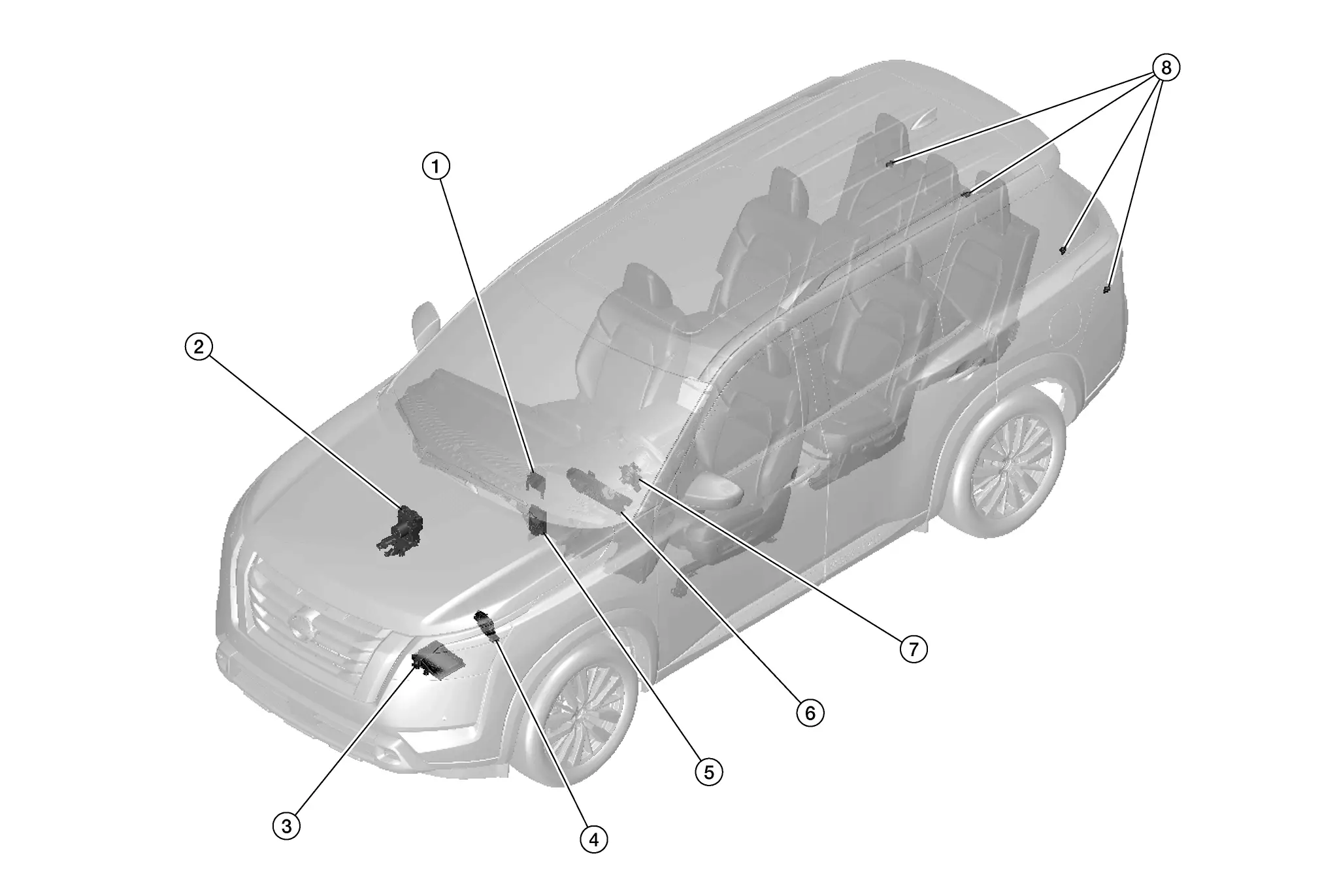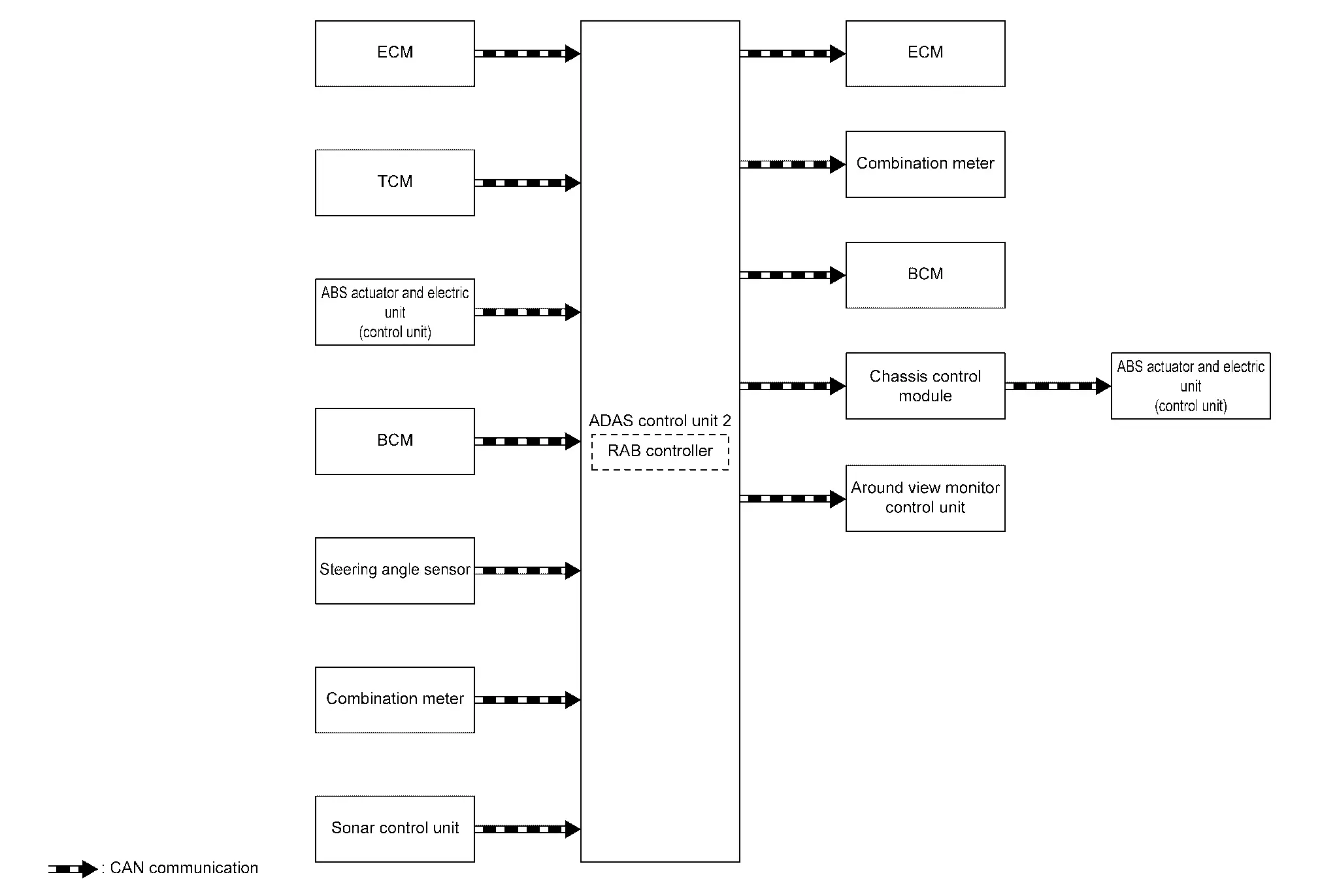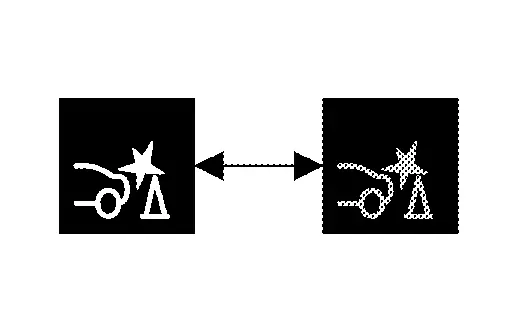Nissan Pathfinder: Brake Control System - System Description
Component Parts Nissan Pathfinder 2022
Rear Automatic Braking System
Component Parts Location

| No. | Component parts | Function | |
|---|---|---|---|
| 1. | Sonar control unit |
Sonar sensors signals are received by the sonar control unit and transmitted to the combination meter via CAN communication for RAB operation. Refer to Component Parts Location for detailed component location. |
|
| 2. | ABS (Anti-lock braking system) actuator and electric unit (control unit) | Refer to ABS Actuator and Electric Unit (Control Unit). | |
| 3. | TCM (Transmission Control Module) | AT control related signal is transmitted to sonar control unit via CAN communication. | |
| 4. | ECM (Engine Control Module) | When Rear Automatic Braking operates, an engine torque down request signal is received from the sonar control unit. | |
| 5. | ADAS (Advanced Driver Assistance System) control unit 2 |
|
|
| 6. | Combination meter |
Performs the following operations using the signals received from the sonar control unit via CAN comunication:
|
|
| 7. | Steering angle sensor |
Transmits the steering angle sensor malfunction signal to ADAS control unit 2, and ABS actuator and electric unit (control unit) via CAN communication Refer to Steering Angle Sensor. |
|
| 8. | Rear sonar sensors | Refer to Rear sonar Sensors. | |
System Nissan Pathfinder 2025
System Description
SYSTEM DIAGRAM

| Component | Function |
|---|---|
| ECM | ECM (With Barometric Pressure Sensor) |
| TCM | TCM |
| ABS actuator and electric unit (control unit) | ABS Actuator and Electric Unit (Control Unit) |
| Chassis control module | Chassis Control Module |
| BCM | System Description |
| Steering angle sensor | Steering Angle Sensor |
| Combination meter (FULL TFT METER) | Combination Meter |
| Combination meter (7 INCH INFORMATION DISPLAY) | Combination Meter |
| Sonar control unit | System Description |
| Around view monitor control unit | Around View Monitor Control Unit |
| ADAS control unit 2 | ADAS Control Unit 2 |
ADAS CONTROL UNIT 2 INPUT/OUTPUT SIGNAL ITEM
Input Signal Item
| Transmit unit | Signal name | Description | |
|---|---|---|---|
| ECM | CAN communication | Closed throttle position signal | Receives idle position state (ON/OFF) |
| Accelerator pedal position signal | Receives accelerator pedal position (angle) | ||
| Engine speed signal | Receives engine speed | ||
| TCM | CAN communication | Input speed signal | Receives the number of revolutions of input shaft |
| Current gear position signal | Receives a current gear position | ||
| Shift position signal | Receives a selector lever position | ||
| Output shaft revolution signal | Receives the number of revolutions of output shaft | ||
| ABS actuator and electric unit (control unit) | CAN communication | ABS malfunction signal | Receives a malfunction state of ABS |
| TCS malfunction signal | Receives a malfunction state of TCS | ||
| VDC malfunction signal | Receives a malfunction state of VDC | ||
| Nissan Pathfinder Vehicle speed signal (ABS) | Receives wheel speeds of four wheels | ||
| Brake fluid pressure signal | Receives brake fluid pressure | ||
| BCM | CAN communication | Stop lamp switch signal | Receives an operational state of the brake pedal |
| Steering angle sensor | CAN communication | Steering angle sensor signal | Receives the number of revolutions, turning direction of the steering wheel |
| Combination meter | CAN communication | System selection signal | Receives a selection state of each item selected with the combination meter |
| Sonar control unit | CAN communication | Sonar sensor signal | Receives obstacle information (existence & distance) |
Output Signal Item
| Reception unit | Signal name | Description | |
|---|---|---|---|
| ECM | CAN communication | Wheel torque request signal | Transmits a signal to control the engine torque |
| Combination meter | CAN communication | Meter display signal | Transmits a signal to display a state of the system on the information display |
| Buzzer output signal | Transmits a signal to activate buzzer | ||
| RAB warning lamp signal |
|
||
| BCM | CAN communication | Stop lamp request signal | Transmits a signal to activates the stop lamp |
| ABS actuator and electric unit (control unit) (via chassis control module) | CAN communication | Brake fluid pressure control signal | Transmits a brake fluid pressure control signal to activates the brake |
| Around view monitor control unit | CAN communication | RAB warning signal | Transmits a RAB warning signal to appear the red frame in the center display |
FUNCTION DESCRIPTION
-
The Rear Automatic Braking system can assist the driver when the vehicle is backing up and approaching objects directly behind the Nissan Pathfinder vehicle.

-
When the shift lever is in the R (Reverse) position and the Nissan Pathfinder vehicle speed is less than approximately 15 km/h (7 MPH), the RAB system operates.
-
The RAB system detects obstacles behind the Nissan Pathfinder vehicle using the sonar sensors.
-
If a risk of a collision with an obstacle is detected when own Nissan Pathfinder vehicle is backing up, the RAB system warning indicator blinks in the vehicle information display, a red frame appears in the center display (with Intelligent Around View Monitor system), and the system chimes three times.
-
The system automatically applies the brakes.
 NOTE:
NOTE:
-
After the automatic brake application, the driver must depress the brake pedal to maintain brake pressure.
-
Driver can temporarily cancel the sonar function in the Nissan Pathfinder vehicle, but the RAB system continues to operate.
-
OPERATION DESCRIPTION
-
Sonar detects a object approaching, and transmits the object detection signal to ADAS control unit 2 via CAN communication.
-
The ADAS control unit 2 performs the following operations according to the degree of possibility of a collision.
-
Transmits the buzzer output signal to the combination meter and sounds the buzzer.
-
Transmits the meter display signal to the combination meter and displays the RAB system warning indicator.
-
Transmits the brake fluid pressure control signal to the ABS actuator and electric unit (control unit) and performs the brake control.
-
Transmits the stop lamp request signal to BCM and turn ON the stop lamp.
-
 NOTE:
NOTE:
-
ON/OFF of RAB system is performed with the combination meter.
-
The RAB system is automatically turned ON when the engine is restarted.
OPERATION CONDITION
ADAS control unit 2 performs the control when the following conditions are satisfied.
-
RAB system: ON
-
Vehicle speed: Less than approximately 15 km/h (9 MPH)
-
When there is a possibility of a collision with the object backward.
CANCEL CONDITION
The ADAS control unit 2 cancels the operation when the system is under any conditions of the operation cancellation condition.
-
When the system judges that the vehicle comes to a standstill by the system control.
-
When the system malfunction occurs.
-
When the sonar area of the rear bumper is dirty and the measurement of the distance between the object becomes difficult.
Fail-safe (ADAS Control Unit 2)
Refer to Fail-safe (ADAS Control Unit 2).
Warning Lamp/Indicator Lamp
Warning Lamp/Indicator Lamp
| Name | Design | Function | |
|---|---|---|---|
| RAB warning lamp |
 |
|
|
Operation Nissan Pathfinder SUV
Operation
SWITCH NAME AND FUNCTION

| No. | Switch name | Description |
|---|---|---|
 |
Steering switch |
|
SYSTEM DISPLAY

| No. | Switch name | Description |
|---|---|---|
 |
RAB warning lamp |
|
 |
RAB indicator | Blinks when there is a possibility of a collision with the object backward |
DISPLAY AND WARNING
System Display
| Condition | Action | Display on information display | Warning lamp | Buzzer | |
|---|---|---|---|---|---|
| RAB OFF | — | — | ON | OFF | |
| RAB ON | There is not a possibility of a collision with the object backward | — | — | OFF | OFF |
| There is a possibility of a collision with the object backward | Operates brake |
White⇔Red
|
OFF | Beep | |
| RAB system malfunction | The RAB system is automatically canceled* |
Malfunction See Owner’s Manual |
ON | Beep | |
| When RAB system cannot be operated temporily | The RAB system is automatically canceled* | — | Blink | OFF | |
Handling Precaution Nissan Pathfinder 2025
Precautions for Rear Automatic Braking
PRECAUTIONS FOR REAR SONAR SENSORS
-
Always keep the rear sonar sensors clean.
-
If the rear sonar sensors are dirty, wipe them off with a soft cloth while being careful to not damage them.
-
Do not subject the area around the rear sonar sensors to strong impact.
-
Do not install any stickers (including transparent stickers) or accessories on the rear sonar sensors and their surrounding areas. This may cause a malfunction or improper operation.
PRECAUTIONS FOR RAB
Failure to follow the warnings and instructions for proper use of the RAB system could result in serious injury or death.
-
The RAB system is a supplemental aid to the driver. It is not a replacement for proper driving procedures. Always use the side and rear mirrors and turn and look in the direction to move before and while backing up. Never rely solely on the RAB system. It is the driver’s responsibility to stay alert, drive safely, and be in control of the Nissan Pathfinder vehicle at all times.
-
There is a limitation to the RAB system capability. The RAB system is not effective in all situations.
Listed below are the system limitations for the RAB system. Failure to follow the warnings and instructions for proper use of the RAB system could result in serious injury or death.
-
When the vehicle approaches an obstacle while the accelerator or brake pedal is depressed, the function may not operate or the start of the operation may be delayed. The RAB system may not operate or may not perform sufficiently due to Nissan Pathfinder vehicle conditions, driving conditions, the traffic environment, the weather, road surface conditions, etc. Do not wait for the system to operate. Operate the brake pedal as soon as necessary.
-
If it is necessary to override RAB operation, strongly press the accelerator pedal.
-
Always checks surroundings and turn to check what is behind the Nissan Pathfinder vehicle before and while backing up. The RAB system detects stationary objects behind the vehicle. The RAB system does not detect the following objects:
-
Moving objects
-
Low objects
-
Narrow objects
-
Wedge-shaped objects
-
Complex-shaped objects
-
Multiple object in close
-
Objects close to the bumper (less than approximately 1 ft [30 cm])
-
Objects that suddenly appear
-
Thin objects such as rope, wire, chain, etc.
-
-
The RAB system may not operate for pedestrians or animals.
-
The RAB system may not operate for the following obstacles:
-
Obstacles located high off the ground
-
Obstacles in a position offset from the Nissan Pathfinder vehicle
-
Obstacles, such as spongy materials or snow, that have soft outer surfaces and can easily absorb a sound wave
-
-
The RAB system may not operate in the following conditions:
-
There is rain, snow, ice, dirt, etc., attached to the sonar sensors.
-
A loud sound is heard in the area around the Nissan Pathfinder vehicle.
-
The surface of the obstacle is diagonal to the rear of the vehicle.
-
The sonar sensors or the area around them are extremely hot or cold.
-
-
The RAB system may unintentionally operate in the following conditions:
-
There is overgrown grass in the area around the Nissan Pathfinder vehicle.
-
There is a structure (e.g., a wall, toll gate equipment, a narrow tunnel, a parking lot gate) near the side of the Nissan Pathfinder vehicle.
-
There are bumps, protrusions, or manhole covers on the road surface.
-
The Nissan Pathfinder vehicle is driving through a draped flag or a curtain.
-
The vehicle is driving on a steep hill.
-
There is an accumulation of snow or ice behind the Nissan Pathfinder vehicle.
-
An ultrasonic wave source, such as another vehicle’s sonar, is near the vehicle.
-
-
Once the automatic brake control operates, it does not operate again if the Nissan Pathfinder vehicle approaches the same obstacle.
-
The automatic brake control can only operate for a short period of time. Therefore, the driver must depress the brake pedal.
-
In the following situations, the RAB system may not operate properly or may not function sufficiently:
-
The Nissan Pathfinder vehicle is driven in bad weather (rain, fog, snow, etc.).
-
The vehicle is driven on a steep hill.
-
The Nissan Pathfinder vehicle’s posture is changed (e.g., when driving over a bump).
-
The vehicle is driven on a slippery road.
-
The Nissan Pathfinder vehicle is turned sharply by turning the steering wheel fully.
-
Snow chains are used.
-
Wheels or tires other than NISSAN recommended are used.
-
The brakes are cold at low ambient temperatures or immediately after driving has started.
-
The braking force becomes poor due to wet brakes after driving through a puddle or washing the Nissan Pathfinder vehicle.
-
-
Turn the RAB system off in the following conditions to prevent the occurrence of an unexpected accident resulting from sudden system operation:
-
The Nissan Pathfinder vehicle is towed.
-
The vehicle is carried on a flatbed truck.
-
The vehicle is on the chassis dynamometer.
-
The Nissan Pathfinder vehicle drives on an uneven road surface.
-
Suspension parts other than those designated as genuine parts are used. (If the Nissan Pathfinder vehicle height or the vehicle body inclination is changed, the system may not detect an obstacle correctly.)
-
-
Excessive noise (e.g., audio system volume, an open Nissan Pathfinder vehicle window) interferes with the chime sound, and it may not be heard.
Diagnosis System (adas Control Unit 2) Nissan Pathfinder 2025
CONSULT Function (ICC/ADAS 2)
Refer to CONSULT Function (ICC/ADAS 2).

Nissan Pathfinder (R53) 2022-2025 Service Manual
System Description
Contact Us
Nissan Pathfinder Info Center
Email: info@nipathfinder.com
Phone: +1 (800) 123-4567
Address: 123 Pathfinder Blvd, Nashville, TN 37214, USA
Working Hours: Mon–Fri, 9:00 AM – 5:00 PM (EST)

